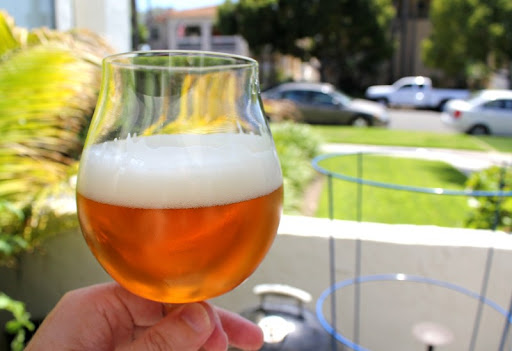IPAison - A West Coast IPA with Saison Yeast

We like IPAs and we like Saisons, so what would we get if we tried combining the two styles?
A very tasty beer, indeed.
We used a West Coast style IPA malt and hop profile, but rather than using our typical California ale yeast we used a Saison strain instead. The Saison yeast (we used White Labs WLP568) adds subtle spicy/fruity overtones that work really well with the hop profile.
We also experimented with some new (for us) hop varieties in this beer, since our go-to hops (Simcoe and Amarillo) were not available.
The "IPAison" has been a really nice summer beer. We'll definitely be putting this recipe (or variants of it) in our regular brewing rotation.
IPAison
A West Coast IPA brewed with a Saison Yeast.
Total batch size = 5 gallons; Partial Mash in 3 gallon beverage cooler; ~3 gallon 60 minute stove-top boil; late malt extract addition; dry hopped for aroma; target abv of 7%
Ingredients:
3 lb Briess Golden Light Dry Malt Extract (DME)2 1/4 lb Briess Pilsen Dry Malt Extract (DME)
5 lb 2-Row Pale Malt
1/2 lb Carapils/Dextrin Malt
1/2 lb Wheat Malt
2 oz Centennial Hops
1 1/2 oz Zythos Hops
1 1/2 oz Summit Hops
1 1/2 oz Horizon Hops
1 tablet Whirlfloc
White Labs WLP568 Saison Ale Yeast Blend
Hop Schedule:
1 oz Centennial - 60 minutes boil1/2 oz Horizon - 30 minutes boil
1/2 oz Zythos - 25 minutes boil
1/2 oz Summit - 15 minutes boil
1/2 oz Horizon - 2 minutes boil
1/2 oz Zythos - 2 minutes boil
1/4 oz Summit - 0 minutes boil
1 oz Centennial - Dry Hop in Secondary Fermenter
3/4 oz Summit - Dry Hop in Secondary Fermenter
1/2 oz Horizon - Dry Hop in Secondary Fermenter
1/2 oz Zythos - Dry Hop in Secondary Fermenter
Heat 8 quarts water to 165 degrees for a target mash temperature of 150 degrees. Place the 6 pounds of crushed grain (2-Row Pale, Wheat and Carapils) into a large mesh bag. Pour the hot water into the beverage cooler, then lower the grain bag into the water very slowly, pushing and prodding with a large spoon to ensure all the grain is wet (this can take several minutes). Put the lid on the cooler and allow to rest 60 minutes.
While the grains are mashing, heat another 5-6 quarts of water to 180-185 degrees for sparging (rinsing the grains). Near the end of the 60 minutes, heat 2 quarts of water to a boil in your brew pot.
After the first mash is complete, remove the cooler lid and open the spigot to draw off about 2 quarts of wort into a large pitcher. The first few draws will likely be cloudy with grain particles; pour it gently back into the cooler over the grain bag to help filter it. Draw off the remaining wort by the pitcher-full and carefully pour that wort into the boiling water in your brew pot; continue until only a trickle of wort leaves the spigot. Pour about 5 quarts of your hot sparge water over the grain bag in the cooler. Gently lift the bag up and down to thoroughly re-wet the grains (but don't slosh). Cover and let sit about 5 minutes. Use the spigot and a pitcher to draw off all of the second wort and add it to your brew pot. (Alternatively, heat the sparge water to 195 and carefully add it a pint at a time while you draw off the first wort. Keep the liquid level 1 inch over the grain bed until all sparge water has been added, then slowly draw off the remainder.)
You should have about 3 gallons of wort. Bring the wort to a boil and add hops according to the schedule. With 15-20 minutes remaining in the boil, begin adding the DME one cup at a time, stirring to dissolve. At time zero, continue adding DME off the heat until all has been added (if needed, return to low heat for a few minutes to help dissolve the extract). Stir in 1 tablet Whirlfloc. Cover and let sit 10-15 minutes.
Move brew pot to an ice bath and cool quickly to less than 80 degrees. Transfer wort to a primary fermenter (straining off the hops if desired). Add water to reach the 5 gallon mark. Swirl vigorously then pitch the yeast.
Ferment in primary for 1 week, then transfer to secondary. After 4 days, add dry hops from hop schedule. Bottle or keg after fermentation is complete (2 to 3 weeks in secondary).






